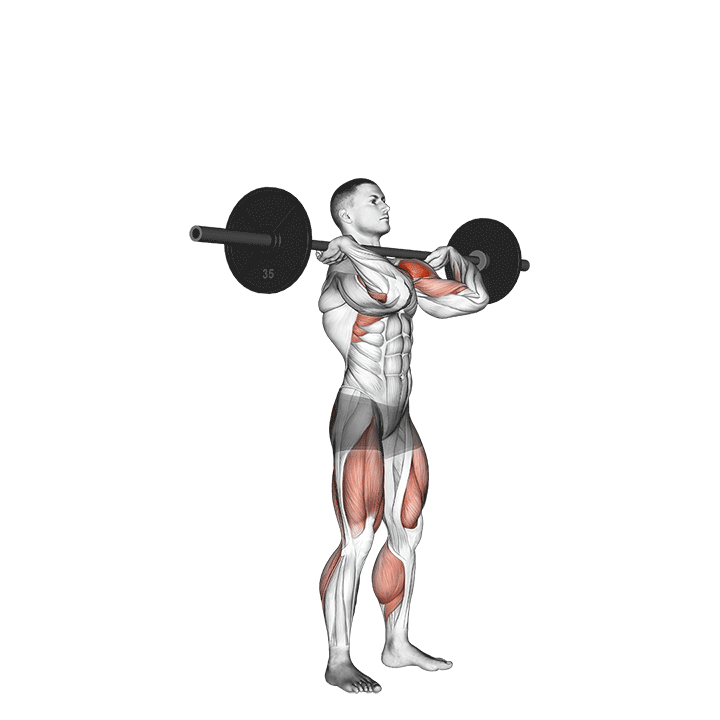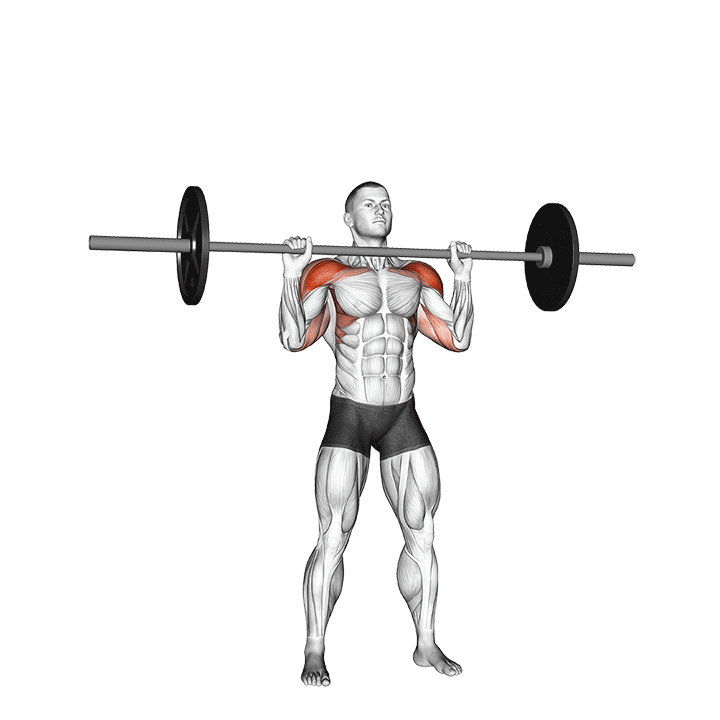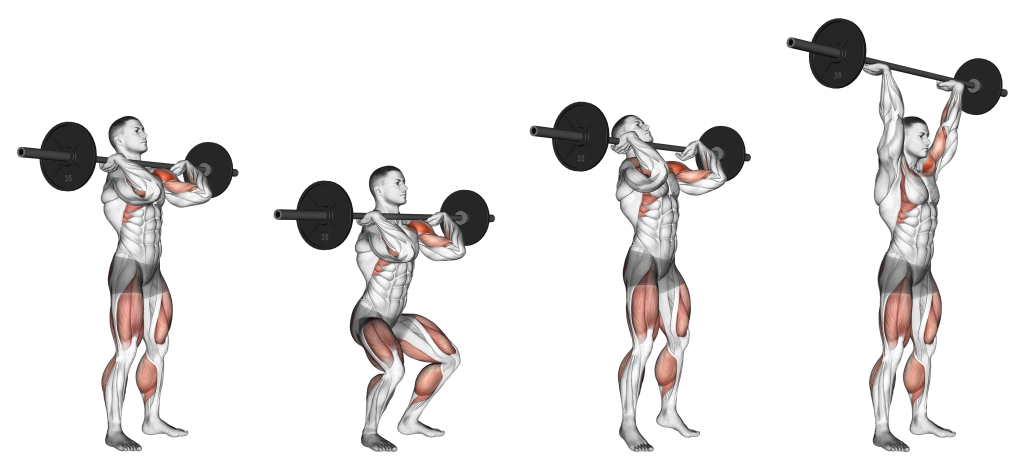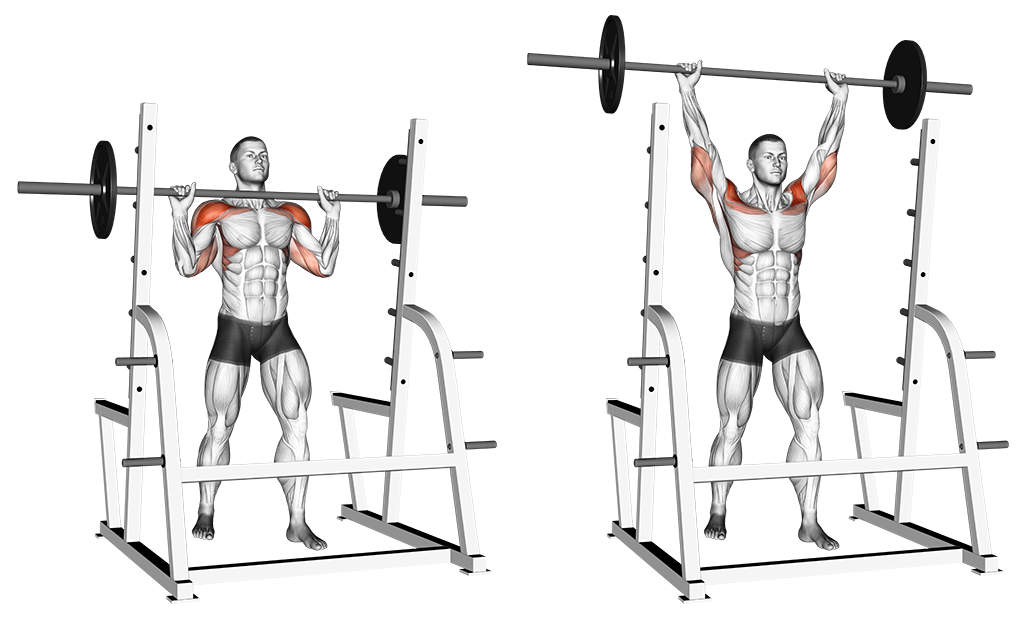Push Press vs Overhead Press: The Differences Explained
Among the various pressing movements available, there are few as effective at their distinctive purposes as the push press and the overhead press; So much so, that they are considered essential exercises in modern resistance training.
What some lifters aren’t aware of, however, is the difference between the two movements - as well as when it’s the right time to do them.
To put it short, the push press is better for athleticism, explosiveness and moving larger amounts of weight, whereas the overhead press is the better exercise for slow and controlled repetitions that produce greater muscular improvements over time.
What is the Push Press?
The push press is a closed kinetic chain compound exercise of significant intensity, often performed with the use of a barbell and set of weight plates for moderate volume sets.

The push press is frequently encountered in athletic or Olympic weightlifting programs as a primary compound exercise, but may also be used as an accessory movement for athletes performing specialized technique work instead.
Benefits of the Push Press
The main benefit of performing the push press is in its capacity to build full-body power development in a single smooth action, just as one would do if performing a high jump or cleaning a barbell overhead.
Its unique form cues and utilization of lower body drive creates an exercise perfectly suited to building explosiveness while still targeting the muscles of the deltoids.
Other benefits of the push press primarily revolve around technical practice in regards to force translation, innate proprioception and familiarity with leverage and resistance - meaning that it is also an excellent exercise for highly advanced athletes seeking an edge in their physical capabilities.
What is the Overhead Press?
The overhead press (also known as the military press) is a closed kinetic chain compound movement, usually done with a barbell and set of weight plates for low to moderate volume sets and a relatively moderate level of resistance.

It is most often seen in bodybuilding or powerlifting training programs as a method of building shoulder strength or size, though it is occasionally supplanted with the incline barbell bench press instead.
Due to the relative simplicity of its form, the overhead press is widely available to lifters of any experience level, and can be seen in workout plans targeted towards novice exercisers as well.
Benefits of the Overhead Press
The main benefit of the overhead press is its effectiveness at training the deltoid muscles - of which is also the reason why it is included in so many training programs.
Unlike the push press, the overhead press will not involve any usage of momentum whatsoever, and is relatively isolated to only the upper body.
Furthermore, the overhead press is one of the best compound exercises for placing time under tension upon the shoulders, maximizing any hypertrophy and strength development possible.
Form Differences of the Push Press and Overhead Press
All the distinctions between the push press and the overhead press lie in the different ways that they are executed, with the push press involving entirely different parts of the body than what the overhead press is normally constrained to.
One may note certain similarities between the push press and the overhead press, and that the only real difference between the two (at least execution-wise) is the involvement of the lower body and the speed with which the barbell is moving in either exercise.
The Push Press
To perform the push press, the exerciser will unrack the barbell and stand in a clear space, the barbell resting at clavicle level and the hands slightly wider than shoulder-width apart.
Setting the feet shoulder-width apart and flexing the core muscles, the exerciser will dip at the hips and knees as if performing a partial squat.

From this position, they will smoothly push through their heels into the floor and simultaneously push the barbell over their head, rotating the torso so the shoulders are at a neutral rotation once the arms are fully extended.
Then, the exerciser needs only to lower the weight back to the starting position, thereby completing the repetition.
The Overhead Press
To perform the overhead press, the exerciser will un-rack the barbell at clavicle-level, having set their hands shoulder-width apart along the bar.

Flexing the core and contracting the shoulders, they will then push the barbell overhead in a slow and controlled manner, stopping once their arms are at a state of full extension.
Holding this position for a count, they will then slowly return the barbell to its original position, thereby completing the repetition.
Muscles Worked by the Push Press and the Overhead Press
While both the push press and the overhead press are primarily deltoid muscle exercises, one can ascertain from form alone that they do not entirely include the same muscle groups.
Both the push press and the overhead press will work the muscles of the deltoids and triceps brachii to a significant extent, but the push press will also involve quite a number of other muscle groups, such as the quadriceps femoris, the lower posterior chain, the trapezius and the pectoral muscles.
In comparison, the overhead press is solely constrained to the deltoids and triceps brachii, exchanging the number of activated muscles for more quality time under tension instead.
Depending on grip width, the pectoral muscles or trapezius may be occasionally worked as well.
Maximal Loading of the Push Press and the Overhead Press
In terms of gross amount of weight that may be moved at maximal effort, the push press allows for significantly greater loads than the overhead press would.
This is entirely due to the utilization of momentum - or what is otherwise known as muscular power.
Because of the increased force being produced by the lower body, the push press may be performed with a greater amount of weight at the same level of muscular exertion than what would be possible with the overhead press.
While this is not necessarily a bad or a good thing, it does influence the sort of training stimulus and subsequent development that may be had.
A greater maximal load (or even working load) equates to greater conditioning in terms of actual maximum strength output. Such conditioning can be quite useful for powerlifters or strongman athletes that need to push their absolute strength as far as possible.
However, this can also mean a greater risk of injury if the push press is performed improperly, as well as the fact that the conditioning developed is not specifically towards the shoulders alone - making the overhead press the more technically advantageous of the two exercises, despite the lighter maximum load.
Explosiveness and Sports Carryover of the Push Press and the Overhead Press
In terms of raw physical explosiveness and the capacity to build pure athleticism in a lifter, it is the push press that is vastly superior to the overhead press.
Not only does the push press involve the usage of full-body momentum derived from the legs, but it also does so in a rapid and intense manner - a physical characteristic known as explosiveness.
The overhead press does not utilize any explosiveness whatsoever, and is purely a movement meant to induce resistance upon the deltoid muscles of the shoulders. Generally, any momentum or usage of the lower body during the exercise defeats the entire purpose.
In short, the push press is far better for athletes or individuals who participate in athletic activities, as it produces functional fitness developments far better than the overhead press.
Strength and Mass Development of the Push Press and the Overhead Press
In terms of pure physical development, the overhead press greatly exceeds the push press as a resistance exercise.
This is due to the two main differences between the overhead press and the push press; specificity of training stimulus, as well as time under tension.
Why the Overhead Press is Better for Strength and Size
Though it is indeed true that the push press recruits more muscle groups than the overhead press and at a greater amount of weight, the overhead press makes up for this difference by having a far more focused scope of muscular recruitment - meaning that the difference in loading will not affect development, as the deltoids and triceps are recruited to a greater intensity despite of it.
Furthermore, the actual length of time in which the deltoids and triceps are recruited is rather short during the push press, as much of the force comes from the lower body.
Conversely, during the overhead press, the deltoids and triceps are the only muscles recruited, requiring that they remain activated throughout the entire repetition. Such a long time under tension equates to a far greater hypertrophic response, meaning more strength and size.
As such, in terms of actual development of their primary mover muscles, the overhead press is arguably better. Especially if pure shoulder strength or size is among the lifter’s training goals.
How to Decide on Which Exercise to Use
With all these distinctions, it may be difficult to actually pick which exercise to use in your training.
Fortunately, deciding between the push press or the overhead press comes down to two factors; what you want out of your training, as well as what sort of training you plan on doing.
Keep in mind that these two exercises are tools, and that one is not necessarily better than the other.
Instead, which movement is more appropriate is based entirely on the context of their usage.
By Training Goals
Deciding on which exercise to perform should take your training goals into account:
- Are you an athlete desiring greater explosiveness?
- A powerlifter seeking pure deltoid strength?
- Perhaps you’re conditioning your body to handling very heavy loads?
Though both the push press and the overhead press share similarities in terms of training stimulus, keep in mind the time under tension of either exercise, as well as the specificity of said stimulus.
The overhead press is arguably better for hypertrophy of the upper body, as its lengthy time under tension and smaller muscular activation fits that type of growth. On the other hand, the push press can help you master the mechanics of hip drive and translating momentum from the legs.
It is up to you and your goals to decide which exercise better fits the sort of training needed.
By Workout Programming
The other factor to take into account when picking an exercise is your workout itself.
The push press includes the lower body into its muscular recruitment pattern, and as such may lead to fatigue and poor performance if performed the day before a leg workout. Conversely, the push press fits perfectly into a full body workout, as many athletic training programs include it.
Furthermore, an absence of general shoulder muscle recruitment in your upper body workout may also indicate that the overhead press is needed, with the opposite being true if your workout already includes plenty of shoulder volume.
Keeping your goals in mind, it is also important to ensure that the exercise you pick fits into your workout program, avoiding overtraining and accumulated fatigue as much as possible.
In Conclusion
In truth, both exercises are perfectly effective, and there are even certain cases where both exercises are the appropriate choice, sometimes together.
Apart from picking the right exercise, remember that it is also important to program them correctly, and to ensure that they are executed with proper form as much as possible.
References
1. Soriano, Marcos & García Ramos, Amador & Torres-González, Antonio & Castillo-Palencia, Joaquín & Marín, Pedro & Sainz de Baranda, Pilar & Comfort, Paul. (2019). Comparison of 1-Repetition-Maximum Performance Across 3 Weightlifting Overhead Pressing Exercises and Sport Groups. International Journal of Sports Physiology and Performance. 15. 1-6. 10.1123/ijspp.2019-0582.
2. Balsalobre-Fernández, C., García-Ramos, A., & Jiménez-Reyes, P. (2018). Load–velocity profiling in the military press exercise: Effects of gender and training. International Journal of Sports Science & Coaching, 13(5), 743–750. https://doi.org/10.1177/1747954117738243
